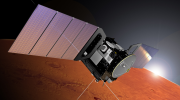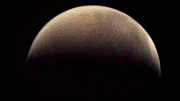ESA’s great Phobos animation – showing a 360-degree view of Phobos – is today’s APOD! What a great way to celebrate the holiday (and MEX’s 10th anniversary of arrival at Mars)! Better yet: Mars Express is lined up to make the closest-ever flyby of Phobos on 29 December, just 45 km from the surface. (There won’t be any images, but we’ll keep you updated here in the blog.)
What does the Martian moon Phobos look like? To better visualize this unusual object, images from ESA’s Mars Express orbiter have been combined into a virtual rotation movie. The rotation is actually a digital illusion – tidally-locked Phobos always keeps the same face toward its home planet, as does Earth’s moon. The above video highlights Phobos’ chunky shape and an unusually dark surface covered with craters and grooves. What lies beneath the surface is a topic of research since the moon is not dense enough to be filled with solid rock. Phobos is losing about of centimeter of altitude a year and is expected to break up and crash onto Mars within the next 50 million years. To better understand this unusual world, Mars Express is on course to make the closest flyby ever on Sunday.




Discussion: 3 comments
Nice!
My quick inspection of the current MEX trajectory on JPL Horizons
suggests that the close approach is 45 km to body center, not the surface as you say here. Can you clarify? Thanks and good luck with the encounter!
Hi Jonathan,
Andy Johnstone at ESOC provided this reply. The 45 km is a good approximation to the surface of Phobos (it’s a potato, not a bowling ball), while the distance to body centre at closest approach will be 58.4 km.
Cheers!
================================
I just checked out JPL Horizons and they state 58km to the [Phobos] body centre:
Date__(UT)__HR:MN Azi_(a-appr)_Elev delta
2013-Dec-29 07:09 .n.a. .n.a. 5.8058826478E+01
And give the dimensions of Phobos as:
Center radii : 13.0 x 11.4 x 9.1 km {Equator, meridian, pole}
Our predictions were given as 58.4km from centre at closest approach. Horizons data is only given to the nearest minute so these do seem to match up.
Best regards,
Andy
Thanks for the confirmation – sorry for the bother, I realize I messed up parsing the Horizons output. But in any case it’s helpful to have the 58 km number – many thanks.